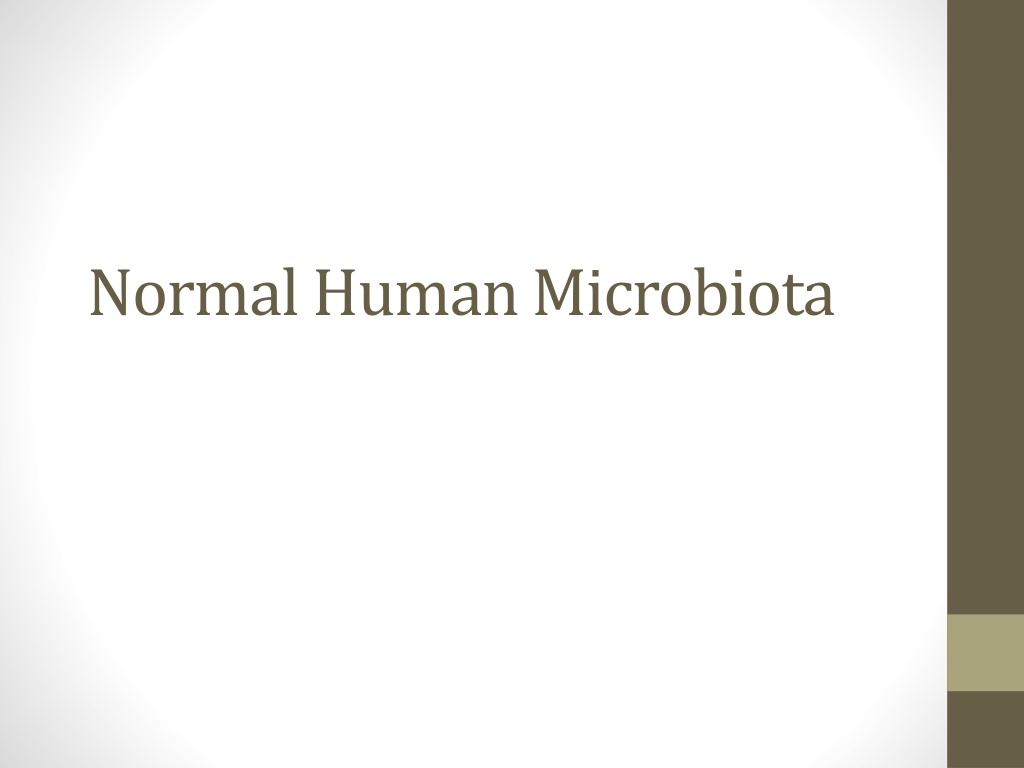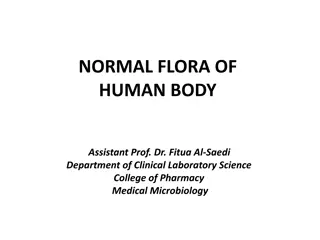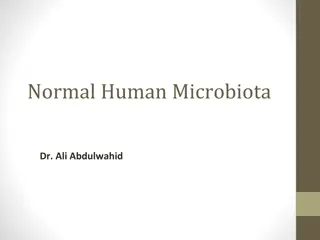Understanding Normal Human Microbiota and Its Role in Health
Normal human microbiota refers to the microorganisms residing on our skin and mucous membranes, playing vital roles in digestion, immunity, and protection against pathogens. They are categorized into resident and transient groups, with resident flora aiding in maintaining health by synthesizing nutrients, preventing pathogen colonization, and engaging in bacterial interference. However, some resident microbes can turn pathogenic under certain conditions. Overall, maintaining a balanced microbiota is crucial for human health.
Download Presentation

Please find below an Image/Link to download the presentation.
The content on the website is provided AS IS for your information and personal use only. It may not be sold, licensed, or shared on other websites without obtaining consent from the author. Download presentation by click this link. If you encounter any issues during the download, it is possible that the publisher has removed the file from their server.
E N D
Presentation Transcript
overview The term normal microbial flora denotes the population of microorganisms that inhabit the skin and mucous membranes of healthy normal persons. The microorganisms that live inside and on humans (now referred to as the normal microbiota ) are estimated to outnumber human somatic and germ cells by a factor of 10. Research has shown that the normal microbiota provides a first line of defense against microbial pathogens, assist in digestion, play a role in toxin degradation, and contribute to maturation of the immune system.
Groups of Human microbiota Human microbiota can be arranged into two groups: 1. the resident microbiota consists of relatively fixed types of microorganisms regularly found in a given area at a given age; if disturbed, it promptly re- establishes itself, 2. the transient microbiota consists of nonpathogenic or potentially pathogenic microorganisms that inhabit the skin or mucous membranes for hours, days, or weeks. The transient microbiota is derived from the environment, does not produce disease, and does not establish itself permanently on the surface.
Members of the transient microbiota are generally of little significance in comparison to the normal resident flora. if the resident microbiota is disturbed, transient microorganisms may colonize, proliferate, and produce disease. The microorganisms that are constantly present on body surfaces are commensals. Their flourishing in a given area depends on physiologic factors of temperature, moisture, and the presence of certain nutrients and inhibitory substances.
The role of normal flora in human health Their presence is not essential to life But the resident flora of certain areas plays a definite role in maintaining health and normal function. Ex.: Members of the resident microbiota in the intestinal tract synthesize vitamin K and aid in the absorption of nutrients. On mucous membranes and skin, the resident microbiota may prevent colonization by pathogens and possible disease through bacterial interference. The mechanism of bacterial interference may involve competition for receptors or binding sites on host cells, competition for nutrients, mutual inhibition by metabolic or toxic products, mutual inhibition by antibiotic
Negative role of microbiota Members of the normal microbiota may themselves produce disease under certain circumstances. These organisms are adapted to a noninvasive mode of life defined by the limitations of the environment. If forcefully removed from the restrictions of that environment and introduced into the bloodstream or tissues, these organisms may become pathogenic. Ex: Bacteroides species are the most common resident bacteria of the large intestine and are quite harmless in that location. If introduced into the peritoneal cavity or into pelvic tissues along with other bacteria as a result of trauma, they cause suppuration and bacteremia.
The normal microbiota of different sites of human body
I. Normal microbiota of the skin The skin is the largest organ in human body It is colonized by a diverse array of microorganisms, most of which are harmless or even beneficial to the host. it is always colonized by transient microorganisms due to its constant exposure to and contact with the environment. There is also a constant and well-defined resident flora, modified in different anatomic areas by secretions, habitual wearing of clothing, or proximity to mucous membranes (mouth, nose, and perineal areas)
I. Normal microbiota of the skin The predominant resident microorganisms of the skin are: 1. aerobic and anaerobic diphtheroid bacilli (eg, Corynebacterium, Propionibacterium); 2. nonhemolytic aerobic and anaerobic staphylococci (Staphylococcus epidermidis and other coagulase-negative staphylococci, occasionally Staphylococcus aureus, and Peptostreptococcus species); 3. grampositive, aerobic, spore-forming bacilli that are ubiquitous in air, water, and soil 4. -hemolytic streptococci (viridans streptococci) and enterococci (Enterococcus species) 5. gram-negative coliform bacilli and Acinetobacter. 6. acid-fast, nonpathogenic mycobacteria occur in areas rich in sebaceous secretions (genitalia, external ear).
Factors affecting the resident and transient flora Factors that important in eliminating nonresident microorganisms from the skin are the low pH, the fatty acids in sebaceous secretions, and the presence of lysozyme. The number of resident microorganisms may be diminished by vigorous daily scrubbing with soap containing disinfectants but the flora is rapidly replenished from sebaceous and sweat glands even when contact with other skin areas or with the environment is completely excluded. Placement of an occlusive dressing on the skin tends to result in a large increase in the total microbial population and may also produce qualitative alterations in the flora.
Infection caused by skin normal flora Anaerobes and aerobic bacteria often join to form synergistic infections (gangrene, necrotizing fasciitis, and cellulitis) of skin and soft tissues. The bacteria are frequently part of the normal microbial flora. It is usually difficult to pinpoint one specific organism as being responsible for the progressive lesion because mixtures of organisms are usually involved.
II. Normal microbiota of the mouth and upper respiratory tract at its earliest stage of community development (<5 minutes postdelivery), the human microbiota is homogeneously distributed across the body. Vaginally delivered infants harbor bacterial communities (in all body habitats) that are most similar in composition to the vaginal communities of the mothers; C-section babies lack bacteria from the vaginal community (eg, Lactobacillus, Prevotella, Atopobium, and Sneathia spp.). Infants delivered via C-section harbor bacterial communities (across all body habitats) that are most similar to the skin communities of the mothers (eg, Staphylococcus, Corynebacterium, or Propionibacterium spp.).
Within 4 12 hours after birth, viridans streptococci become established as the most prominent members of the resident flora Early in life, aerobic and anaerobic staphylococci, g-ve diplococci (neisseriae, Moraxella catarrhalis), diphtheroids, and occasional lactobacilli are added. When teeth begin to erupt, the anaerobic spirochetes, Prevotella species (especially Prevotella melaninogenica), Fusobacterium species, Rothia species, and Capnocytophaga species establish themselves along with some anaerobic vibrios and lactobacilli. Actinomyces species are normally present in tonsillar tissue and on the gingivae in adults, and various protozoa may also be present. Yeasts (Candida species) occur in the mouth.
The flora of the nose consists of prominent corynebacteria, staphylococci (S epidermidis, S aureus), and streptococci. In the pharynx and trachea, a similar flora establishes itself, but few bacteria are found in normal bronchi. Small bronchi and alveoli are normally sterile. The predominant organisms in the upper respiratory tract, particularly the pharynx, are non hemolytic and -hemolytic streptococci and neisseriae. Staphylococci, diphtheroids, haemophili, pneumococci, mycoplasmas, and prevotellae are also encountered.
Infections caused by mouth and respiratory tract normal flora Infections of the mouth and respiratory tract are usually caused by mixed oronasal flora, including anaerobes. Periodontal infections, perioral abscesses, sinusitis, and mastoiditis may involve predominantly Prevotella melaninogenica, Fusobacteria, and Peptostreptococci. Aspiration of saliva (containing up to 100 of these organisms and aerobes) may result in necrotizing pneumonia, lung abscess, and empyema.
III. Normal Microbiota of the Intestinal Tract The Diet and the environment (eg, maternal vaginal, fecal, or skin microbiota) is a major factor in determining the early microbial profile. At birth, the intestine is sterile, but organisms are soon introduced with food. The intestinal microbiota of breastfed children is dominated by Bifidobacteria. However, recent studies Suggested that in most babies, Bifidobacteria did not appear until several months after birth and thereafter persisted as a minority population. In bottle-fed children, a more mixed flora exists in the bowel, and lactobacilli are less prominent. Bowels of newborns in intensive care nurseries tend to be colonized by Enterobacteriaceae, such as Klebsiella, Citrobacter, and Enterobacter
In normal adults, the esophagus contains microorganisms arriving with saliva and food. The stomach s acidity keeps the number of microorganisms at a minimum (102 103/mL of contents The normal acid pH of the stomach markedly protects against infection with some enteric pathogens (eg, Vibrio cholerae). As the pH of intestinal contents becomes alkaline, the resident flora gradually increases. In the upper intestine, the bacterial population associated with the mucosa include the phylum Bacteroidetes and members of the Clostridiales, and those of the lumen can include members of the Enterobacteriales and
In the sigmoid colon and rectum, the bacteria constitute about 60% of the fecal mass. Anaerobes outnumber facultative organisms by 1000-fold. In a normal adult colon, 96 99% of the resident bacterial flora consists of anaerobes. Six major phyla predominate; these are Bacteroidetes, Firmicutes, Actinobacteria, Verrucomicrobiota, Fusobacteria, and Proteobacteria. More than 100 distinct types of organisms, occur regularly in normal fecal flora. Archae are represented primarily by the methane producers species such as Methanobrevibacter stadtmanae other types of microbes are present, such as protozoans and fungi, whose functions are less well understood.
The importance of intestine microbiota The important functions of intestinal microbiota can be divided into three major categories (: 1. Protective functions : in which the resident bacteria displace and inhibit potential pathogens indirectly by competing for nutrients and receptors or directly through the production of antimicrobial factors, such as bacteriocins and lactic acid. 2. Commensal organisms are important for the development and function of the mucosal immune system. They induce the secretion of IgA, influence the development of the intestinal humoral immune system, modulate local T-cell esponses and cytokine profiles.
The importance of intestine microbiota 3. A broad range of metabolic functions: They contribute to the amino acid requirements of the host if they are not provided by the diet itself. produce short-chain fatty acids that control intestinal epithelial cell differentiation. They synthesize vitamin K, biotin, and folate and enhance ion absorption. Certain bacteria metabolize dietary carcinogens and assist with fermentation of nondigestible dietary residue. There is now evidence that gut bacteria can influence fat deposition in the host, leading to obesity
Infections with intestinal microbiota in genetically susceptible individuals, some components of the flora can result in disease. For example, inflammatory bowel diseases are believed to be associated with a loss of immune tolerance to bacterial antigens. This leads to intense inflammation caused by an exuberant immune response. mechanisms may be important in intestinal malignancy such as colon cancer.
IV. Normal microbiota of the urethra The anterior urethras of both sexes contain small numbers of the same types of organisms found on the skin and perineum. These organisms regularly appear in normal voided urine in numbers of 102 104/mL.
V. Normal microbiota of the vagina Soon after birth, aerobic lactobacilli appear in the vagina and persist as long as the pH remains acidic (several weeks). When the pH becomes neutral (remaining so until puberty), a mixed flora of cocci and bacilli is present. At puberty, aerobic and anaerobic lactobacilli reappear in large numbers and contribute to the maintenance of acid pH through the production of acid from carbohydrates, particularly glycogen. This appears to be an important mechanism in preventing the establishment of other, possibly harmful microorganisms in the vagina. if lactobacilli are suppressed by the administration of antimicrobial drugs, yeasts or various bacteria increase in numbers and cause irritation and inflammation.
Bacterial vaginosis: is a syndrome marked by dramatic shifts in the types and relative proportions of the vaginal microbiota as the vaginal ecosystem changes from a healthy, characterized by the presence of lactobacilli, to a diseased state characterized by the presence of organisms belonging to phylotaxa such as Actinobacteria and Bacteroidetes species.
The normal vaginal flora includes group B streptococci in as many as 25% of women of childbearing age. During the birth process, a baby can acquire group B streptococci, which subsequently may cause neonatal sepsis and meningitis. The normal vaginal flora often includes also -hemolytic streptococci, anaerobic streptococci (peptostreptococci), Prevotella species, clostridia, Gardnerella vaginalis, Ureaplasma urealyticum, and sometimes Listeria or Mobiluncus species
VI. Normal microbiota of the conjunctiva The predominant organisms of the conjunctiva are diphtheroids, S epidermidis, and nonhemolytic streptococci. Neisseriae and gram-negative bacilli resembling haemophili (Moraxella species) are also frequently present. The conjunctival flora is normally held in check by the flow of tears, which contain antibacterial lysozyme.
References Jawetz, M. & Adelberg s. 2013. Medical Microbiology , Twenty- Sixth Edition. The McGraw-Hill Companies, Inc. USA























